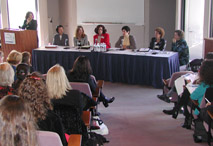National laboratory women gather at LBL to explore employee pipeline issues

“Widening the winner’s circle” is how Rep. Ellen Tauscher, D-Calif., described the way the US will retain dominance in the 21st century in her remarks at the third Laboratory Women’s Forum, “Women of Influence at the National Laboratories.”
Convened at Lawrence Berkeley National Laboratory (LBL) last month, the forum was attended by more than 150 participants from Sandia, Lawrence Livermore, Los Alamos, and Lawrence Berkeley national laboratories.
Richard Nolan, director of the Berkeley Site Office of DOE’s Office of Science, echoed Tauscher’s message. Attracting and retaining talent, he said, is of critical importance to DOE and to the world because under-utilization of women seriously impinges on the security needs of the nation. “It’s clear we need you,” he said, “to lead us forward into the 21st century.”
Women in science/technology
Although women represent about half the workforce, they accounted for only 19 percent of the science and technology sector in 1991 and 26 percent in 2003, he said, although that sector was growing more quickly than the rest of the workforce.
Tauscher experienced changing opportunities when she was one of the first women to join the New York Stock exchange after graduating from college in 1974. “Globalism hit financial markets before any other business,” she said. “They needed people and talent. This was the wave of the future.”
Tauscher inspired the first forum by asking laboratory women in Livermore to contribute ideas to the Commission on the Advancement of Women and Minorities in Science, Engineering, and Technology Development. Held in San Ramon in 2000, it resulted in policy recommendations regarding recruitment, recognition, workplace flexibility, and the image of women in technical fields. Two of the recommendations were forwarded to the National Academy of Sciences Commission on Women in Science and Engineering, said Jane Ann Lamph (8755), who recapped progress in remarks at the most recent forum.
Policy, benefit proposals
Judy Moore (16000), co-chair for the Sandia Women’s Action Network, added that Sandians followed up by proposing policy and benefit changes to make Sandia an employer of choice. Her co-chair Georgianne Smith (3000) attended with others in Albuquerque by videolink.
“We really have taken action and made a difference,” said Deputy Director Pat Falcone (8110).
Los Alamos women, who learned about Sandia’s ombuds program, established one there, said LANL Technical Staff Member Wendee Brunish. Although women make up 32 percent of the workforce, they account for 52 percent of the ombuds clientele, she noted.
Lawrence Livermore women focused on championing having more women in middle and upper management, which resulted in several upper-level recruitments, including Associate Director for Computation Dona Crawford, a former director from Sandia/California (she had been a panelist at the first forum and introduced Tauscher at this forum).
The host of the October forum, LBL’s Chief Facilities Planner Laura Chen, said she was the sole participant from her facility at the second forum, held in 2002 in Albuquerque. The recently appointed LBL director, Steven Chu, kicked off the forum with remarks about how the laboratories can be made more hospitable. “Things are getting better,” he concluded. “But things can be a lot better.”
California Laboratory Vice President Mim John spoke about the impacts of nationalscience and technology issues on the labs. “The world has changed,” she said, with the threat of a massive nuclear attack diminishing but the acquisition of nuclear capabilities growing. She called for the labs to engage in the policy debate as well as technical solutions, saying, “The challenges are enormous. The nation expects us to be there when we’re needed.”
Karen Ramorino, deputy of the Administrative Services Department of LBL, spoke about workforce demographics. She said that among technical workers, the ranks of women who were unmarried, had nonworking spouses, or saw work-life balance as an obstacle were 34 percent, 10 percent, and 21 percent, respectively, while for men, the numbers were 17 percent, 38 percent and 2.8 percent. (The statistics are from a 2004 paper by Shirley Tilghman of Princeton University, “Ensuring the Future Participation of Women in Science, Mathematics and Engineering”.)
Ramorino also said that men can be as effective as women as role models.
Also speaking from LBL was Deputy Director Pier Oddone, who described how successful women can also be role models for men. Instituting improvements over time, he said, is an effort that has to be carried out in parallel and on many fronts.
That was essentially Tauscher’s call to action. “There are millions of young girls out there,” she said, “and our work is to build a ladder for them to places we couldn’t go. Unless we make this part of our own personal agenda, we cannot make sure this will be done. We will find the way, because we are meant to do it. It is for our legacy that they will work.”